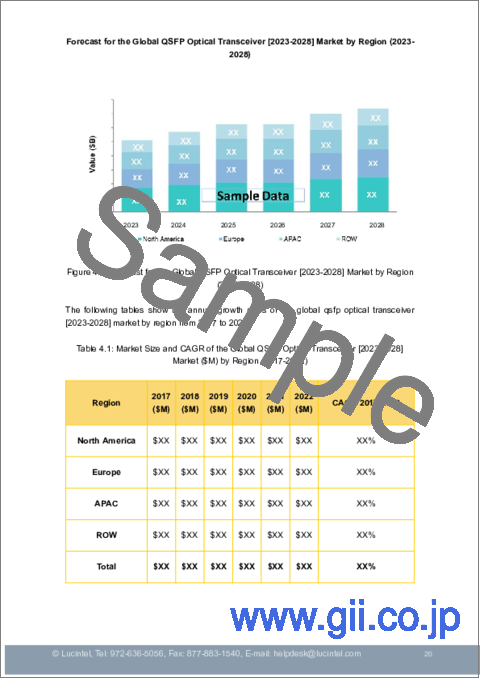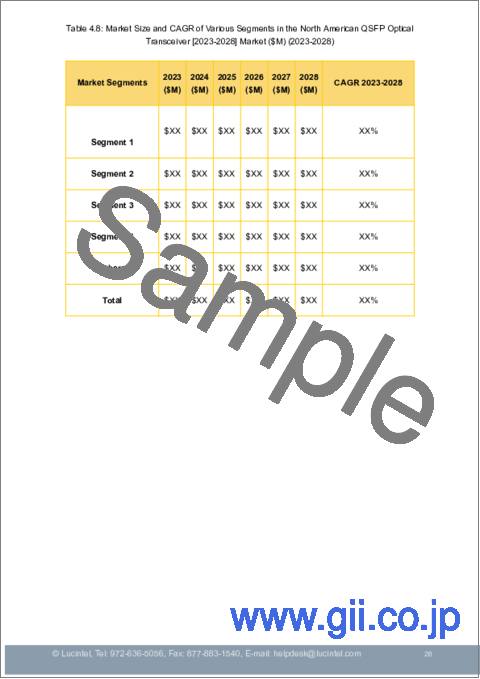|
|
市場調査レポート
商品コード
1277647
QSFP光トランシーバー市場:動向、機会、競合分析【2023年~2028年】QSFP Optical Transceiver Market: Trends, Opportunities and Competitive Analysis [2023-2028] |
||||||
|
● お客様のご希望に応じて、既存データの加工や未掲載情報(例:国別セグメント)の追加などの対応が可能です。 詳細はお問い合わせください。 |
|||||||
| QSFP光トランシーバー市場:動向、機会、競合分析【2023年~2028年】 |
|
出版日: 2023年05月01日
発行: Lucintel
ページ情報: 英文 150 Pages
納期: 3営業日
|
- 全表示
- 概要
- 目次
QSFP光トランシーバーの市場動向と予測
世界のQSFP光トランシーバー市場は、2023年から2028年までのCAGRが14.3%で、2028年までに推定28億米ドルに達すると予測されています。この市場の主な促進要因は、スイッチやその他のネットワーク機器を銅線やファイバーケーブルに接続し、ファイバーポートを追加するためのQSFPの使用が増加していることです。QSFP光トランシーバー市場の将来は、テレコム、データセンター、企業向けアプリケーションでのビジネスチャンスが期待できそうです。
QSFP光トランシーバーの参入企業一覧
同市場の企業は、提供する製品の品質に基づいて競争しています。この市場の主要企業は、製造施設の拡大、研究開発投資、インフラ整備、バリューチェーン全体における統合機会の活用に注力しています。これらの戦略により、QSFP光トランシーバー企業は需要増への対応、競争力の確保、革新的な製品・技術の開発、製造コストの削減、顧客基盤の拡大を図っています。
QSFP光トランシーバー市場の洞察
- Lucintelは、この400Gイーサネットモジュールは、1G SFPモジュールの400倍であるギバーチャネルよりも高い帯域幅を持つため、予測期間中にイーサネットが最も成長すると予測しています。
- データセンターは、高速かつ長距離伝送が可能なため、予測期間中に最も高い成長が見込まれます。
- 北米は、様々な最終用途産業においてQSFPの需要が高まっているため、予測期間中に最も高い成長を遂げると予想されています。
本レポートでは、以下の11の主要な質問に回答しています:
- Q.1.市場セグメントのうち、最も有望かつ高成長な機会は何か?
- Q.2.どのセグメントがより速いペースで成長するのか、またその理由は?
- Q.3.どの地域がより速いペースで成長すると思うか、またその理由は?
- Q.4.市場力学に影響を与える主要因は何か?この市場における主な課題とビジネスリスクは何か?
- Q.5.この市場におけるビジネスリスクと競合の脅威は何か?
- Q.6.この市場における新たな動向とその理由は何か?
- Q.7.この市場における顧客の要求の変化にはどのようなものがあるのか?
- Q.8.市場における新たな開拓は何か?これらの開発をリードしているのはどの企業か?
- Q.9.この市場における主要なプレーヤーは誰か?主要プレーヤーは事業成長のためにどのような戦略的取り組みを進めているのか?
- Q.10.この市場における競合製品にはどのようなものがあり、材料や製品の代替別市場シェア喪失の脅威はどの程度あるのか?
- Q.11.過去5年間で、どのようなM&Aが行われ、業界にどのような影響を与えたか?
目次
第1章 エグゼクティブサマリー
第2章 QSFP光トランシーバーの世界市場:市場力学
- イントロダクション、背景、分類
- サプライチェーン
- 業界を牽引する要因と課題
第3章 2017年から2028年までの市場動向と予測分析
- マクロ経済動向(2017年~2022年)および予測(2023年~2028年)
- 世界のQSFP光トランシーバーの市場動向(2017年~2022年)と予測(2023年~2028年)
- QSFP光トランシーバーの世界市場:データレート別
- 10Gbps未満
- 10 Gbps~40 Gbps
- 41 Gbps~100 Gbps
- 100Gbps以上
- QSFP光トランシーバーの世界市場:ファイバータイプ別
- シングルモードファイバー
- マルチモードファイバー
- QSFP光トランシーバーの世界市場:プロトコル別
- Ethernet
- ファイバーチャネル
- CWDM/DWDM
- FTTx
- その他
- QSFP光トランシーバーの世界市場:アプリケーション別
- 通信
- データセンター
- エンタープライズ
第4章 2017年から2028年までの地域別市場動向と予測分析
- QSFP光トランシーバーの世界市場:地域別内訳
- 北米のQSFP光トランシーバー市場
- 欧州のQSFP光トランシーバー市場
- アジア太平洋のQSFP光トランシーバー市場
- その他地域のQSFP光トランシーバー市場
第5章 競合分析
- 製品ポートフォリオ分析
- 経営統合
- ポーターのファイブフォース分析
第6章 成長機会と戦略的分析
- 成長機会分析
- QSFP光トランシーバーの世界市場の成長機会:データレート別
- QSFP光トランシーバーの世界市場の成長機会:ファイバータイプ別
- QSFP光トランシーバーの世界市場の成長機会:プロトコル別
- QSFP光トランシーバーの世界市場の成長機会:用途別
- QSFP光トランシーバーの世界市場の成長機会:地域別
- QSFP光トランシーバーの世界市場の新興動向
- 戦略的分析
- 新製品開発
- QSFP光トランシーバーの世界市場の生産能力増強
- QSFP光トランシーバーの世界市場におけるM&A、ジョイントベンチャー
- 認証とライセンシング
第7章 主要企業プロファイル
- Perle Systems
- Lumentum
- Sumitomo Electric Industries
- Accelink
- Applied Optoelectronics
- Fujitsu Optical Components
QSFP Optical Transceiver Market Trends and Forecast
The future of the QSFP optical transceiver market looks promising with opportunities in the telecom, data center, and enterprise applications. The global QSFP optical transceiver market is expected to reach an estimated $2.80 billion by 2028 with a CAGR of 14.3% from 2023 to 2028. The major drivers for this market are increasing use of QSFP to attach switches or other network devices to copper or fibre cable and add fibre ports.
A more than 150-page report is developed to help in your business decisions.
QSFP Optical Transceiver Market by Segment
The study includes a forecast for the global QSFP optical transceiver market by data rate, fiber type, protocol, application, and region, as follows.
QSFP Optical Transceiver Market by Data Rate [Value ($B) Shipment Analysis from 2017 to 2028]:
- Less Than 10 Gbps
- 10 Gbps to 40 Gbps
- 41 Gbps to 100 Gbps
- More Than 100 Gbps
QSFP Optical Transceiver Market by Fiber Type [Value ($B) Shipment Analysis from 2017 to 2028]:
- Single Mode Fiber
- Multimode Fiber
QSFP Optical Transceiver Market by Protocol [Value ($B) Shipment Analysis from 2017 to 2028]:
- Ethernet
- Fiber Channel
- CWDM/DWDM
- FTTx
- Others
QSFP Optical Transceiver Market by Application [Value ($B) Shipment Analysis from 2017 to 2028]:
- Telecom
- Data Center
- Enterprise
QSFP Optical Transceiver Market by Region [Value ($B) Shipment Analysis from 2017 to 2028]:
- North America
- Europe
- Asia Pacific
- The Rest of the World
List of QSFP Optical Transceiver Companies
Companies in the market compete on the basis of product quality offered. Major players in this market focus on expanding their manufacturing facilities, R&D investments, infrastructural development, and leverage integration opportunities across the value chain. With these strategies QSFP optical transceiver companies cater to increasing demand, ensure competitive effectiveness, develop innovative products & technologies, reduce production costs, and expand their customer base. Some of the QSFP optical transceiver companies profiled in this report include.
- Perle Systems
- Lumentum
- Sumitomo Electric Industries
- Accelink
- Applied Optoelectronics
- Fujitsu Optical Components
QSFP Optical Transceiver Market Insights
- Lucintel forecasts that ethernet is expected to witness highest growth over the forecast period as this 400G ethernet module has higher bandwidth than giber channel, which is 400 times than the original 1G SFP module.
- Data center is expected to witness highest growth over the forecast period as it ensures high speeds and long-distance transmission.
- North America is expected to witness highest growth over the forecast period due to the growing demand for QSFP among various end use industries in the region.
Features of the QSFP Optical Transceiver Market
- Market Size Estimates: QSFP optical transceiver market size estimation in terms of value ($B)
- Trend And Forecast Analysis: Market trends (2017-2022) and forecast (2023-2028) by various segments and regions.
- Segmentation Analysis: QSFP optical transceiver market size by various segments, such as by data rate, fiber type, protocol, application, and region
- Regional Analysis: QSFP optical transceiver market breakdown by North America, Europe, Asia Pacific, and the Rest of the World.
- Growth Opportunities: Analysis on growth opportunities in different by data rate, fiber type, protocol, application, and regions for the QSFP optical transceiver market.
- Strategic Analysis: This includes M&A, new product development, and competitive landscape for the QSFP optical transceiver market.
- Analysis of competitive intensity of the industry based on Porter's Five Forces model.
FAQ
Q1. What is the QSFP optical transceiver market size?
Answer: The global QSFP optical transceiver market is expected to reach an estimated $2.80 billion by 2028.
Q2. What is the growth forecast for QSFP optical transceiver market?
Answer: The global QSFP optical transceiver market is expected to grow with a CAGR of 14.3% from 2023 to 2028.
Q3. What are the major drivers influencing the growth of the QSFP optical transceiver market?
Answer: The major drivers for this market are increasing use of QSFP to attach switches or other network devices to copper or fibre cable and add fibre ports.
Q4. What are the major segments for QSFP optical transceiver market?
Answer: The future of the QSFP optical transceiver market looks promising with opportunities in the telecom, data center, and enterprise applications.
Q5. Who are the key QSFP optical transceiver companies?
Answer: Some of the key QSFP optical transceiver companies are as follows.
- Perle Systems
- Lumentum
- Sumitomo Electric Industries
- Accelink
- Applied Optoelectronics
- Fujitsu Optical Components
Q6. Which QSFP optical transceiver segment will be the largest in future?
Answer: Lucintel forecasts that ethernet is expected to witness highest growth over the forecast period as this 400G ethernet module has higher bandwidth than giber channel, which is 400 times than the original 1G SFP module.
Q7. In QSFP optical transceiver market, which region is expected to be the largest in next 5 years?
Answer: North America is expected to witness highest growth over the forecast period due to the growing demand for QSFP among various end use industries in the region.
Q8. Do we receive customization in this report?
Answer: Yes, Lucintel provides 10% Customization Without any Additional Cost.
This report answers following 11 key questions:
- Q.1. What are some of the most promising, high-growth opportunities for the QSFP optical transceiver market by data rate (less than 10 gbps, 10 gbps to 40 gbps, 41 gbps to 100 gbps, and more than 100 gbps), fiber type (single mode fiber and multimode fiber), protocol (ethernet, fiber channel, CWDM/DWDM, FTTx, and others), application (telecom, data center, and enterprise), and region (North America, Europe, Asia Pacific, and the Rest of the World)?
- Q.2. Which segments will grow at a faster pace and why?
- Q.3. Which region will grow at a faster pace and why?
- Q.4. What are the key factors affecting market dynamics? What are the key challenges and business risks in this market?
- Q.5. What are the business risks and competitive threats in this market?
- Q.6. What are the emerging trends in this market and the reasons behind them?
- Q.7. What are some of the changing demands of customers in the market?
- Q.8. What are the new developments in the market? Which companies are leading these developments?
- Q.9. Who are the major players in this market? What strategic initiatives are key players pursuing for business growth?
- Q.10. What are some of the competing products in this market and how big of a threat do they pose for loss of market share by material or product substitution?
- Q.11. What M&A activity has occurred in the last 5 years and what has its impact been on the industry?
Table of Contents
1. Executive Summary
2. Global QSFP Optical Transceiver Market: Market Dynamics
- 2.1: Introduction, Background, and Classifications
- 2.2: Supply Chain
- 2.3: Industry Drivers and Challenges
3. Market Trends and Forecast Analysis from 2017 to 2028
- 3.1: Macroeconomic Trends (2017-2022) and Forecast (2023-2028)
- 3.2: Global QSFP Optical Transceiver Market Trends (2017-2022) and Forecast (2023-2028)
- 3.3: Global QSFP Optical Transceiver Market by Data Rate
- 3.3.1: Less Than 10 Gbps
- 3.3.2: 10 Gbps To 40 Gbps
- 3.3.3: 41 Gbps To 100 Gbps
- 3.3.4: More Than 100 Gbps
- 3.4: Global QSFP Optical Transceiver Market by Fiber Type
- 3.4.1: Single Mode Fiber
- 3.4.2: Multimode Fiber
- 3.5: Global QSFP Optical Transceiver Market by Protocol
- 3.5.1: Ethernet
- 3.5.2: Fiber Channel
- 3.5.3: CWDM/DWDM
- 3.5.4: FTTx
- 3.5.5: Others
- 3.6: Global QSFP Optical Transceiver Market by Application
- 3.6.1: Telecom
- 3.6.2: Data Center
- 3.6.3: Enterprise
4. Market Trends and Forecast Analysis by Region from 2017 to 2028
- 4.1: Global QSFP Optical Transceiver Market by Region
- 4.2: North American QSFP Optical Transceiver Market
- 4.2.1: North American QSFP Optical Transceiver Market by Protocol: Ethernet, Fiber Channel, CWDM/DWDM, FTTx, and Others
- 4.2.2: North American QSFP Optical Transceiver Market by Application: Telecom, Data Center, and Enterprise
- 4.3: European QSFP Optical Transceiver Market
- 4.3.1: European QSFP Optical Transceiver Market by Protocol: Ethernet, Fiber Channel, CWDM/DWDM, FTTx, and Others
- 4.3.2: European QSFP Optical Transceiver Market by Application: Telecom, Data Center, and Enterprise
- 4.4: APAC QSFP Optical Transceiver Market
- 4.4.1: APAC QSFP Optical Transceiver Market by Protocol: Ethernet, Fiber Channel, CWDM/DWDM, FTTx, and Others
- 4.4.2: APAC QSFP Optical Transceiver Market by Application: Telecom, Data Center, and Enterprise
- 4.5: ROW QSFP Optical Transceiver Market
- 4.5.1: ROW QSFP Optical Transceiver Market by Protocol: Ethernet, Fiber Channel, CWDM/DWDM, FTTx, and Others
- 4.5.2: ROW QSFP Optical Transceiver Market by Application: Telecom, Data Center, and Enterprise
5. Competitor Analysis
- 5.1: Product Portfolio Analysis
- 5.2: Operational Integration
- 5.3: Porter's Five Forces Analysis
6. Growth Opportunities and Strategic Analysis
- 6.1: Growth Opportunity Analysis
- 6.1.1: Growth Opportunities for the Global QSFP Optical Transceiver Market by Data Rate
- 6.1.2: Growth Opportunities for the Global QSFP Optical Transceiver Market by Fiber Type
- 6.1.3: Growth Opportunities for the Global QSFP Optical Transceiver Market by Protocol
- 6.1.4: Growth Opportunities for the Global QSFP Optical Transceiver Market by Application
- 6.1.5: Growth Opportunities for the Global QSFP Optical Transceiver Market by Region
- 6.2: Emerging Trends in the Global QSFP Optical Transceiver Market
- 6.3: Strategic Analysis
- 6.3.1: New Product Development
- 6.3.2: Capacity Expansion of the Global QSFP Optical Transceiver Market
- 6.3.3: Mergers, Acquisitions, and Joint Ventures in the Global QSFP Optical Transceiver Market
- 6.3.4: Certification and Licensing
7. Company Profiles of Leading Players
- 7.1: Perle Systems
- 7.2: Lumentum
- 7.3: Sumitomo Electric Industries
- 7.4: Accelink
7:5: Applied Optoelectronics
7:6: Fujitsu Optical Components




